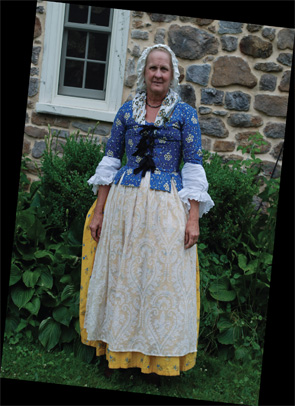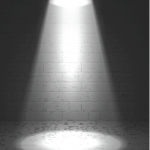
If a physician from the 18th century were to walk into Donah Zack Crawford’s home, he would be well equipped to practice medicine.
Crawford, director of clinical trials at the Arthritis Group in Philadelphia, collects medical instruments and literature, mostly from the 18th century. Her home study is filled with roughly 200 different objects, like a mid-18th century apothecary chest that contains many original bottles. She often brings smaller items with her when conducting presentations for school children, seniors and others at community libraries. They’re also showcased at reenactments and in museums as far north as Quebec, Canada, and as far south as San Juan, Puerto Rico. Her goal is to educate people about the evolution of medicine and how healthcare was delivered more than 300 years ago.
Strong Stomach
Crawford’s hobby began more than 25 years ago, after accompanying her then 8-year-old son to Revolutionary War reenactments.
“You have to do something if you’re spending a lot of time out and about in camp,” she says. “Cooking did not interest me. … I have rheumatoid arthritis, so holding a needle and sewing at camp was not [possible]. I was coordinating clinical trials at the University of Pennsylvania at the time, and one thing sort of led to another.”
Her collection includes surgical tools, such as scalpels and a bone-handled crimper, which resembles pruning shears, that was used to amputate gangrenous fingers and toes, various sizes of mortars and pestles, and also dental tools. The only tools missing, Crawford says, are those related to obstetrics, which are very expensive.
Her husband, a part-time antique dealer, helps purchase some tools, and others are bought from antique stores, yard sales and even antique gun shows. She explains that people drawn to antique guns are also attracted to pointy or sharp objects, which are sometimes medical instruments.
Crawford says many of the instruments have not changed in centuries. For example, she points to dentistry, which she believes is the most evolved of the medical disciplines. (Listen to Ms. Crawford talk about the surgical instruments, bleeding and more.)
Except for their composition, she says there’s very little difference between dental probes and other tools used centuries ago and those used by dentists today. She owns a set of dental tools from England and another from France.
“They invented the right tools about 400 years ago, and they still work,” says Crawford. “I’ve taken my dental tools to my dentist. He thinks they’re way cool.”
So do schoolchildren. For roughly a dozen years, she shared her knowledge several mornings a week with students in the Washington Crossing and Brandywine School Districts, and then taught 21st century medicine in the afternoons.
She says many people forget how their ancestors survived surgeries without anesthesia. “Most of the world has completely forgotten about what it was like to be an active participant in your [own] surgery,” Crawford says.
To help children better understand, she often shares stories that were written in a diary by a Quaker woman during the 18th century. One involved her 5-year-old daughter, who was ill, being bled and had leeches placed near incisions on her hand, leg and stomach.
Because the subject matter often requires a strong stomach, she asks the children to sit on the floor. If they become queasy or lightheaded when she talks about how these tools were used, she says they don’t have far to fall if they faint.
Shared Practices, Clean Streets
Among her favorite possessions is a reprint of a book written in the 1750s by a British physician, Sir John Pringle, called Diseases of the Army. During the American Revolution, she says, a U.S. physician, Dr. Benjamin Rush, applied Dr. Pringle’s medical concepts and techniques. After the war, Dr. Rush republished the book, adding a forward, along with annotations throughout the book about how and when he used Dr. Pringle’s procedures, both on and off the battlefield.
Crawford is also considering authoring a book, but of a different sort, tentatively titled, “So as to Create a Nuisance.” It would focus on sanitation practices in the 18th century.
Years ago, she explains that her husband requested her help in saving a historic building, the Lazaretto, which was the first quarantine hospital in the U.S., built in 1799, in Essington, Pa. While spending 60 hours in the archives of the Philadelphia library researching the building’s history, she stumbled on “a whole lot of other good, gory things,” she says.
Apparently, in the mid- to late-18th century, the Sanitation Committee, which was part of the city’s Board of Health, was trying to clean up the streets of Philadelphia. Its members understood that proper sanitation was essential for the community’s good health.
So the Committee invited people in the community to point fingers at those committing unsanitary acts and then wrote reports about the incidents that always ended with the phrase, “so as to create a nuisance.”
For example, Crawford says a citizen might report that on the corner of Second and Market streets, a woman empties her chamber pot out of the 3rd floor window under the cover of darkness “so as to create a nuisance.” The Committee would then send someone to watch the house. If the act were repeated, the person would be fined and the watcher would receive a bit of reward money.
But not all the tales were true. At the time, cows, chickens and other animals had free reign to graze around the city. If a cow happened to die on a street corner, the city would dispose of it and fine the owner. However, she says some people were fined even though their animal was very much alive.
She envisions writing her book during retirement, which may not be for another five years. Until then, she’ll keep hunting for more information and instruments that reflect medicine’s past.
What attracts Crawford to this unusual hobby can be summed up in several words: “The good, the gory and the gruesome,” she says. “I love that.”
Carol Patton, a freelance writer based in Las Vegas, Nev., writes the Rheum after 5 column for The Rheumatologist.


